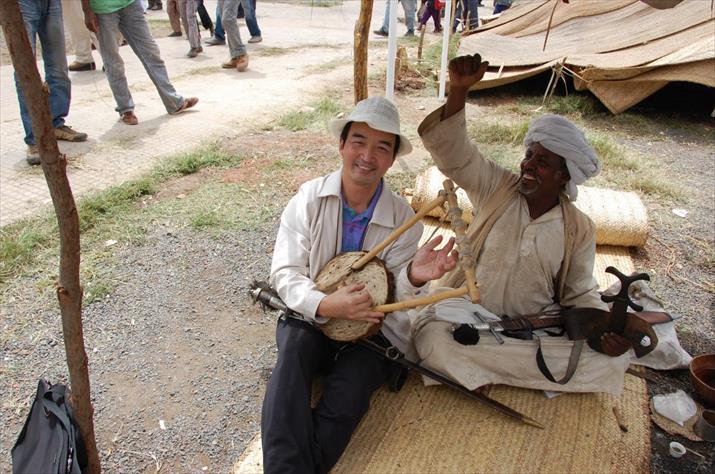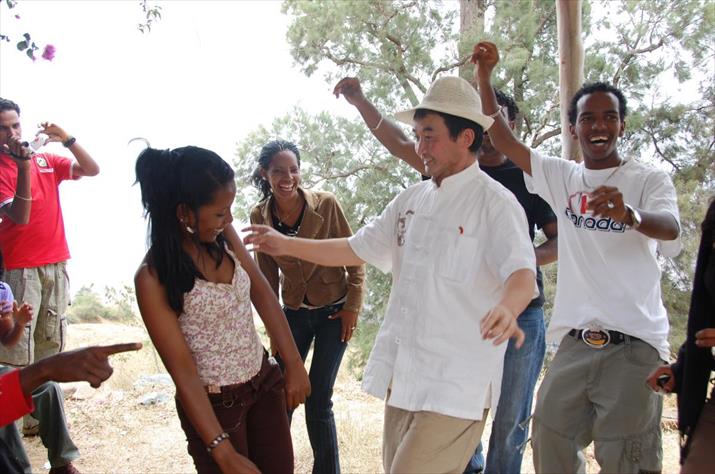|
||||||||||
| Home Nation World Business Opinion Lifestyle ChinAfrica Multimedia Columnists Documents Special Reports |
|
||||||||||
| Home Nation World Business Opinion Lifestyle ChinAfrica Multimedia Columnists Documents Special Reports |
| Lifestyle |
| Moving Together |
| A Chinese artistic director works with African colleagues to promote local arts and culture |
| By Cui Xiaoqin | VOL. 9 July 2017 ·2017-07-12 |

"Through my experience in Africa, I became deeply fascinated with this piece of land, and I have plans to direct more African dance performances in the future," Lin told ChinAfrica.
Lin recalled his trip to Eritrea in 2011 where he was to direct an important performance. As he was about to get off the airplane and step on Eritrean soil after a 20-hour flight in February that year, he felt strangely nervous. He said that the feeling was somehow similar to how he used to feel minutes before stepping on stage for a dance performance, he told ChinAfrica.
Lin had been entrusted by the Eritrean Government to direct a large-scale dance performance for the country's most important cultural event - the 2011 Eritrean Festival Expo, to be held in the capital Asmara in August.
Lin was confident in being up to the task. After all, as the Chairman of Mianyang Dancers Association, in southwest China's Sichuan Province, he had many years of experience under his belt. Moreover, he was not alone in this, as his fellow Eritrean dance directors were expecting his arrival, eager to work with him on such an important project.
"Africa is rich in local art and original tribal culture, which are valuable artistic resources. Every time I go to Africa, I hope to work with my local partners to better use these resources," Lin said.
First steps
It was not Lin's first move on the continent. In 2006, he had previously worked as a directing consultant in the Central African Republic for an important event.
"I was invited to direct a large group of gymnasts for the 46th Independence Day celebrations of the country," Lin told ChinAfrica. Working hands in hands with local artistic troupes, Lin added various elements to the celebrations, ultimately creating a show that fully reflected the theme of the important event.
After three months' rehearsal, the show was presented with a resounding success, and received high praises from his hosts.
This success established his reputation as a first-class director throughout the continent. Two years later, in 2008, Lin was invited by the Eritrean Government to contribute his expertise and ideas to a large-scale theatrical performance in celebration of the country's Independence Day. Again, he lived up to his reputation with a breathtaking show.
"Every time I go to a new place to design or direct a show, I have to understand the cultural background of the event and understand the history of the country," said Lin on the reasons behind his success. "I collect local folk elements in advance so that I can design more practicable and attractive performances."

This is how he ended up taking part in Eritrean Festival Expo in 2011, the biggest celebration of the country. As usual, he did not disappoint the public: The large-scale dance performance was a high point of the opening ceremony. With larger-scale choreographies involving some 3,000 to 4,000 dancers, the performance turned out to be a visual feast.
"The performance was entitled Dream for Peace. I used local Eritrean traditional symbols to express our wish for peace," Lin said. Olive branches - a part of Eritrea's national emblem - were used as props, and actors imitated the movements of a dove, he added.
"Dance is an artistic language that can express not only political themes, but also the feelings of a modern people," Lin said. According to the feedback information after the performance, local people said the dance was innovative and that they could fully understand the traditional symbols used.
Two to tango
More than just directing, Lin puts a special emphasis on exchanging with his fellow directors in Africa, he said. But in doing so, the language barrier remains an important hurdle.
Eritrea has nine ethnic groups, each one of them has its own culture and art; but Lin had only one interpreter to assist him. The difficulty was made worse by the fact that he had to deal with everything from theme selection to dance arrangements and even lighting.
Fortunately, Lin trained a number of Eritrean junior directors with whom he worked in 2008 when he prepared for the Independence Day's celebrations that year. "So, when I came back in 2011, I was happy to reunite and work side by side with them," Lin said. His previous students had now become his partners, and played a key role in the preparations for the festival.
Désiré Kolingba, Former Minister of Youth, Sports, Arts and Culture of the Central African Republic, praised Lin's work. "As the Chinese say, it is better to teach a person how to fish rather than just give him some fish. Lin has done just that in training artistic directors for our country, which will promote the development of performing arts nationwide."
A worthy spirit
African people's strong connection with their ethnic culture is what made the strongest impression on him, Lin said. During the performance of Eritrean Festival Expo in 2011, each one of the country's ethnic groups had its booth to introduce some aspects of its culture. Lin was impressed by their sense of community and the overall respect for diversity.
Over the past years, Chinese authorities have made significant efforts to promote and preserve China's intangible cultural heritage, said Lin. But he believes that there is still work to be done to reach this kind of commitment to cultural diversity among common citizens.
"It is good to develop cultural tourism products, and we should combine cultural heritage protection with economic development. But in this process, we need to make sure that we protect our cultural heritage, and not undermine our cultural ecology," Lin said, adding that Africa's spirit of ethnic culture protection is an example China can learn from.
According to Lin, there is still a lot to do in this field, as Africa's rich original art and culture are not fully discovered. His only wish is that such performances can help spread African culture and bring financial returns to improve the livelihood of African artists.
|
||||||
| About Us | Contact Us | Advertise with Us | Subscribe |
| Copyright Beijing Review All rights reserved 京ICP备08005356号-5 京公网安备110102005860号 |